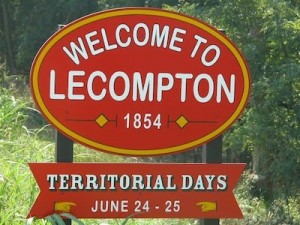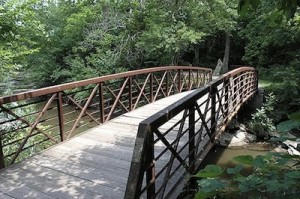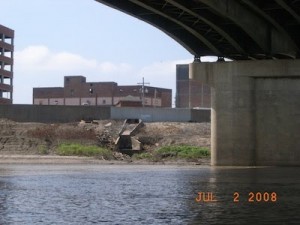View Life on the Kaw: The Inspirational Kaw in a larger map. Click here for help with our maps.
 The meandering Kansas River and rolling landscapes that unfold beside it have been a source of inspiration for many creative artists. Painters, photographers, sculptors, poets, and writers add new dimensions to our understanding of the river. In addition, the arts are important for economic development in many towns along the Kaw. The entire area is rich with museums, galleries, public art, festivals, local books, and other outlets for Kaw residents’ creativity and enjoyment.
The meandering Kansas River and rolling landscapes that unfold beside it have been a source of inspiration for many creative artists. Painters, photographers, sculptors, poets, and writers add new dimensions to our understanding of the river. In addition, the arts are important for economic development in many towns along the Kaw. The entire area is rich with museums, galleries, public art, festivals, local books, and other outlets for Kaw residents’ creativity and enjoyment.
Kansas City, Kansas
Starting at the mouth of the river, the city of Kansas City, Kansas, in a big Queen Anne style house, is the Strawberry Hill Museum and Cultural Center (pictured on right.) The house was built in 1887 and sold in 1919 to St. John the Baptist Catholic Church next door. The church used it as an orphanage for 70 years, adding a dormitory in 1926. The museum celebrates the immigrants who moved to Kansas City, Kansas, in the early 1900s—first the Irish, Germans, and Swedes, then, later, the Croatians and Russians. There is a movement within the Kansas City, Kansas, community to revitalize the entire area from Fourth to Seventh Street between Minnesota and Central avenues. Although most houses in the area are modest by contemporary standards, the area is rich in cultural history and a wonderful example of the American melting pot where cultures from all over the world came together.
Overland Park
In Overland Park, Johnson County Community College has built an impressive art collection, with works displayed throughout the campus and in the new, 4,000-square foot Nerman Museum of Contemporary Art. To learn the campus locations of the art works and gallery hours, click here.
Johnson County Community College is also home to the Carlsen Center for the Performing Arts, which brings world-class theater, dance and music productions. For the current schedule, click here.
Lenexa
The city of Lenexa celebrates its heritage as the “Spinach Capital of the World” with a festival each September. Among the festival’s attractions is a juried arts and fine crafts show. For this year’s festival, click here. Johnson County’s Mill Creek Streamway Park runs through Lenexa. Pictured on right is the trail running through Little Mill Creek Park.
Lawrence
Lawrence (pictured above) bills itself as a city of the arts, with the art beginning literally on the banks of the Kaw. On the north side of the river, just east of the bridge into downtown, is a rock mural created by Stan Herd, an internationally known crop artist. He creates paintings visible from the air or from a distance by selectively planting, mowing, and plowing.
Downtown Lawrence is home to several art galleries, and there is an annual Art Walk that provides an opportunity to meet some of the Lawrence area’s finest artists, visit artists’ studios that are not usually open to the general public, and purchase locally produced art. Once a month, spring through fall, there is an Art Market at the Visitor Center in the historic depot north of the river. The Lawrence Arts Center is home to visual and performing arts, and always has exhibits open to the public. The Lawrence Art Guild sponsors several well-attended art sales each year, including Art in the Park and the Holiday Art Fair. Also, the city of Lawrence has for more than 20 years sponsored a Downtown Lawrence Outdoor Sculpture Exhibition, featuring works from artists nationwide. The sculptures are placed in various locations throughout the downtown area for about a year before a new group is selected and installed.
The University of Kansas (KU) in Lawrence also offers a wealth of art and cultural activities with its outstanding permanent collection of American and international, ancient and contemporary art works and its acclaimed changing exhibitions. The Spencer Art Museum is open to the public. The KU School of Fine Arts, which includes music and drama as well as the visual arts, offers numerous free performances and exhibits throughout the year. The Lied Center of Kansas presents high-quality performances by established and emerging professional, national and international performing artists. Lawrence has also been praised for the strength of its contemporary music scene.
Haskell Indian Nations University in Lawrence is home to the Haskell Cultural Center and Museum Archives. The museum’s permanent exhibit traces Haskell’s history from its founding in 1884 as an agriculture training school for Indian children to its current status as a university with more than 1,000 students. Haskell’s vision is to become a national center for American Indian research, education, and cultural programs. The Haskell Archives collection consists of administrative records, history books, student rosters, theatre and music programs, photographs, films, and videotapes of Haskell events, and the student-run Indian Leader newspaper and yearbook. The Frank A. Rinehart collection consists of 809 glass negatives made by Rinehart and his assistant Adolph Muhr in 1898, 1899, and 1900 in Omaha, Nebraska, many at the Trans-Mississippi Exposition and Indian Congress held in Omaha in 1898. In addition to the archival information, Haskell also owns a valuable collection of museum artifacts from its 118-year history, which includes traditional clothing, jewelry, basketry, pottery, beadwork, and art by such well-known artists as Don Secondine, Alan Houser, Franklin Gritts, and Dick West. The Haskell-Baker Wetlands(pictured on left in photograph courtesy of Craig Thompson) are also located on Haskell University grounds.
Lecompton
In Lecompton, the “bleeding Kansas” era is well-explained through exhibits in two museums: Constitution Hall State Historic Site and the Territorial Capital Museum at Lane University. Lectures and reenactments are scheduled frequently, at the link above.
Topeka
Topeka has a lively arts scene, with 12 art galleries and 5 performing arts facilities. The city boasts its own Symphony Orchestra and Youth Orchestra. The Topeka Performing Arts Center hosts national music and theater performances. Washburn University has White Concert Hall and the Alice C. Sabatini Art Gallery. Art fairs and music festivals are an important component of civic life in the capital.
As for the Capitol building itself, the rotunda features a mural of John Brown, painted by renowned artist John Steuart Curry. West of downtown, the Kansas Museum of History offers superb history and art exhibits. The museum’s grounds include nature trails, a native prairie, and a restored 1800s school.
Although the riverfront in downtown Topeka (pictured on left) has long been an industrial area, efforts are underway to make better use of the Kaw waterfront. The Topeka-Shawnee County Riverfront Development Authority has hired an architectural firm to solicit ideas from community residents and present a proposal. The development may include hiking and biking trails, a visitors center, shops, and restaurants.
Wamego
Wamego, a small town on the north side of the Kansas River, has an extraordinary art history. On its main street, Lincoln Avenue, is the Columbian Theatre, which houses the only art works remaining from the Columbian Exposition and World’s Fair of 1893. The fair celebrated the 400th anniversary of Columbus’ visit to America and attracted more than 27 million visitors—nearly half of the U.S. population—in the six months it was open. J.C. Rogers, a banker from Wamego, was so taken with the fair that he returned to Chicago when the fair closed and purchased two complete buildings from the exposition, plus many statues, paintings, and decorative pieces from other buildings. Rogers incorporated many of his art treasures into a building on Lincoln Street. The second-story windows were from the Brazil Pavilion at the exposition (designed by a team of architects that included the young Frank Lloyd Wright), and the tin eagle on the roof today came from the Government Building. Four magnificent oil paintings by the German artist Earnest Theodor Behr were installed on the second floor. The true value of his acquisitions wasn’t known until 1990, when Wamego residents decided to restore the theater. Beneath the stage they found a crate with 14 additional paintings from the exposition.
The Columbian Theatre is open for tours and has an art gallery and gift shop on the first floor. The theater is still used for theatrical and musical performances. For current events, click here.
Manhattan
Manhattan, home to Kansas State University, offers many attractions for art lovers. The Strecker-Nelson Gallery is a privately owned gallery featuring regional artists. The Beach Museum of Art at K-State(pictured above), which features Kansas and regional art, is open to the public, and there are numerous performing arts events in the city and at the university. For a current schedule, click here.
The Artists
Many highly regarded painters, photographers, musicians, actors, and writers have made their homes in the Kaw Valley. It’s not possible to name them all, but here is a sampling of the inspiration many have found in the landscapes of the Kaw.
Painters
Aaron Douglas, Harlem renaissance artist, 1899-1979
Lisa Grossman, who is profiled in the next section
Nancy Marshall, who is profiled in the next section
More paintings by present and past artists.
Photographers
Gordon Parks, photographer, writer, film director, and composer, 1912-2006
Craig Thompson, who is profiled in the next section
Writers
Langston Hughes, Harlem Renaissance poet and novelist, 1902-1967
Ken Lassman, author of Wild Douglas County, a bioregional approach to living on the prairie.
Denise Low, Poet Laureate of Kansas 2007-2009
Laura Moriarty, contemporary novelist
William Burroughs, novelist and essayist, 1914-1997
Elizabeth Schultz, writer and poet, who is profiled in the next section. Read her poem “Watching the Kansas River”








